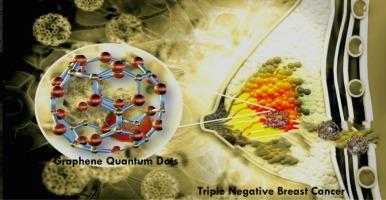石墨烯量子点作为三阴性乳腺癌的纳米治疗剂:三维肿瘤模型的启示
IF 20.3
1区 化学
Q1 CHEMISTRY, INORGANIC & NUCLEAR
引用次数: 0
摘要
化疗是治疗乳腺癌(BC)的基本方法,可用于早期和晚期乳腺癌的治疗。三阴性乳腺癌(TNBC)以其侵袭性和转移倾向而闻名,由于其对标准化疗方法的耐药性,给治疗带来了巨大挑战。鉴别 TNBC 的分子靶点势在必行,尤其是在缺乏特异性靶向药物以及该疾病预后普遍较差的情况下。虽然纳米医学已取得了长足的发展,纳入了多种临床应用,但剂量限制毒性和有限的患者反应率等挑战仍阻碍着纳米医学的广泛应用。在过去十年中,石墨烯量子点(GQDs)已成为一类前景广阔的发光材料,其特点是具有出色的光电特性、高度可调的结构和表面功能。这些特性使 GQDs 成为药物载体的理想候选材料,有利于直接功能化、提高化疗敏感性和药物负载能力。本综述深入探讨了将 GQDs 应用于乳腺癌的最新进展,并特别关注 TNBC。它深入探讨了乳腺癌的动态变化,强调了 TNBC 在诊断和治疗方面的挑战以及 GQDs 在这方面的创新潜力。此外,它还讨论了各种基于 GQD 的治疗策略,这些策略有望提高乳腺癌的治疗效果,从而有可能在 TNBC 的管理方面取得变革性进展。此外,这篇综述还纳入了三维(3D)肿瘤模型的见解,为 GQD 介导的乳腺癌治疗干预提供了一个全面的视角。本文章由计算机程序翻译,如有差异,请以英文原文为准。


Graphene quantum dots as nanotherapeutic agents for triple-negative breast cancer: Insights from 3D tumor models
Chemotherapy is a fundamental modality in the treatment of breast cancer (BC), employed across both early and advanced stages. Triple-negative breast cancer (TNBC), known for its aggressive behavior and propensity for metastasis, presents significant treatment challenges due to its resistance to standard chemotherapeutic approaches. Identifying molecular targets for TNBC is imperative, especially in the absence of specifically targeted drugs and given the generally poor prognosis of the disease. Although nanomedicine has substantially grown, incorporating a variety of clinical applications, challenges such as dose-limiting toxicities and limited patient response rates continue to hinder its broader application. Over the past decade, graphene quantum dots (GQDs) have emerged as a promising category of luminescent materials, characterized by their outstanding optoelectronic properties, and their highly tunable structures and surface functionalities. These attributes make GQDs ideal candidates as drug carriers, facilitating straightforward functionalization, heightened chemotherapy sensitivity, and substantial drug loading capacities. This review provides a thorough exploration of recent advancements in GQDs applied to BC, with a specific focus on TNBC. It delves into the dynamics of breast cancer, emphasizing the diagnostic and therapeutic challenges of TNBC and the innovative potential of GQDs in this context. Furthermore, it discusses various GQD-based therapeutic strategies that hold promise for enhancing outcomes in breast cancer treatment, potentially leading to transformative advancements in the management of TNBC. Additionally, this review incorporates insights from three-dimensional (3D) tumor models, offering a comprehensive perspective on GQD-mediated interventions in breast cancer therapy.
求助全文
通过发布文献求助,成功后即可免费获取论文全文。
去求助
来源期刊

Coordination Chemistry Reviews
化学-无机化学与核化学
CiteScore
34.30
自引率
5.30%
发文量
457
审稿时长
54 days
期刊介绍:
Coordination Chemistry Reviews offers rapid publication of review articles on current and significant topics in coordination chemistry, encompassing organometallic, supramolecular, theoretical, and bioinorganic chemistry. It also covers catalysis, materials chemistry, and metal-organic frameworks from a coordination chemistry perspective. Reviews summarize recent developments or discuss specific techniques, welcoming contributions from both established and emerging researchers.
The journal releases special issues on timely subjects, including those featuring contributions from specific regions or conferences. Occasional full-length book articles are also featured. Additionally, special volumes cover annual reviews of main group chemistry, transition metal group chemistry, and organometallic chemistry. These comprehensive reviews are vital resources for those engaged in coordination chemistry, further establishing Coordination Chemistry Reviews as a hub for insightful surveys in inorganic and physical inorganic chemistry.
 求助内容:
求助内容: 应助结果提醒方式:
应助结果提醒方式:


